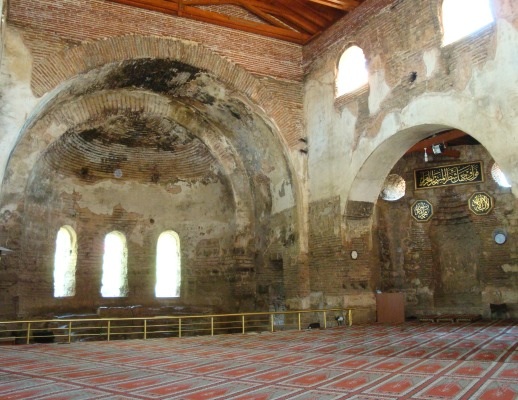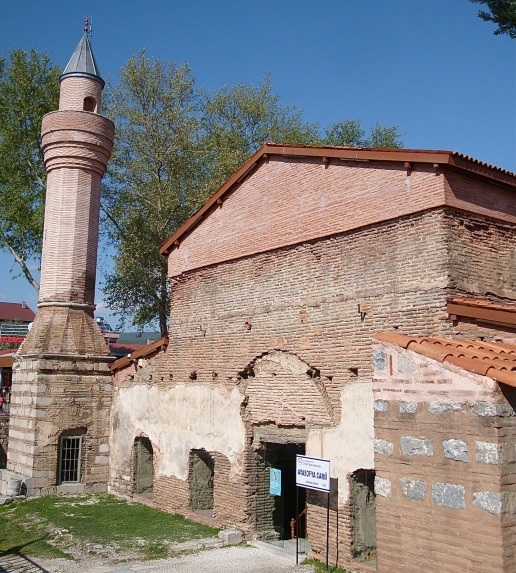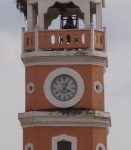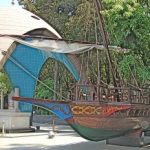At the entrance to what was once the Byzantine church of Hagia Sophia in İznik I feel my steps faltering. Beside the door stands a big new sign. Ayasofya, it says, this being the Turkish rendering of Hagia Sophia (Holy Wisdom), but beside it in smaller letters it also says Orhan Cami, and there’s the rub. Last time I visited what were then the ruins of the church where the Seventh Ecumenical Council was held in 773 the fact that it had been converted into a mosque at a later date had been quietly forgotten. Now, though, the church has been completely restored/rebuilt and the site has been reconsecrated as a mosque.
With a sigh I drag on a headscarf and step inside. Fortunately there is no need to remove my shoes as well since the conversion into a mosque turns out to have taken the form of the insertion of a praying platform into the middle of the building. It’s true there is now a clear mihrab which directs the attention of worshippers away from the old Christian altar and towards Mecca, but it’s still possible to promenade around the “church” without stepping onto the carpeted platform, hence no need for the removal of footwear.
To be honest I’m a bit flummoxed by the whole situation. When I first read that the church had been converted into a mosque I felt a wave of fury. Wasn’t this the site where the Nicene Creed laying out the fundamental principles of Christianity was drawn up? Wasn’t this, then, a particularly important monument to the Christian faith that should have been sacrosanct in a modern age when stamping one’s victorious mark on the monuments of the losers should be a complete no-no? Wasn’t this a comparable sacrilege to the one at Ayodhya in India that eventually led to rioting and deaths?
But then I reread my history books and found that the ruined basilica that I had visited several times in the past was actually a later structure that had played host to the later Ecumenical Council at which iconclasm had been consigned to the pages of history. That being the case perhaps it wasn’t quite such an insult after all. In any case, the only way to be sure was to go and take a look for myself.
Strolling round the church on a public holiday I was pleased to see Turkish families taking a great interest in it and to hear the custodian pointing out the fresco of Christ with his mother and St John the Baptist now curiously low down at floor level. But it was while I was inspecting the neat little synthronon (tiered seats) behind the altar that I was struck by the fact that I was sharing the space with two Turkish women who were not wearing headscarves.
“Excuse me,” I said. “I don’t want to be rude but I was curious about why you didn’t feel that you should put on a scarf.” There was, after all, a box of them by the door for those who’d forgotten to bring their own.
The woman I’d spoken to smiled a tad sheepishly. “You know,” she answered. “I never even thought of it.”
For her, then, the site remained primarily an archaeological site, albeit one that had had its roof returned to it. Back at the door I paused to chat to the custodian. “Why was it turned back into a mosque?” I asked him.
“I don’t know,” he said with a shrug.
“Before it was a museum and I didn’t need to put on a scarf but now it’s a mosque and I do,” I said trying not to sound too bolshy.
“It doesn’t matter whether you wear one or not,” he replied. “We don’t mind. It’s what’s in your heart that matters. A young woman might come in here in a short skirt and no scarf but have a pure heart while someone else comes in covered up but with hatred in her heart. That’s what’s important.”
Smiling, I stepped outside into the sun, removed my own scarf and ambled round the corner to have my footwear given a new lease of life by a shoeshine man. “İznik is lovely. It’s so quiet,” I commented.
“Yes, old people come here to retire,” he said. “You don’t have to worry about pickpockets or thieves here.”
“And the young people?”
“Well, they go to Bursa or Orhangazı to the factories,” he said. “There’s no work here. It’s a protected historic area so no one can build factories. There’s just tourism.”
Back in my pension by glorious Lake İznik I ask the owner how the season is shaping up. She looks a little wistful. “Not good,” she said. “We used to get lots of French people but now they’re not coming.”
“And why is that?” I asked.
“Well, look what they’ve done to Ayasofya,” she replied. “They used to come here to see that and now they don’t.”
“Why do you think they turned it back into a mosque?” I asked.
“Politics,” she said. “You know, the government…” And we left the meaning behind that comment hanging unspoken in the air.
Actually I doubt very much that that is why the French aren’t coming this year. News of the church’s rebuilding only started to circulate towards the end of last year, too late in the day for tour groups to cancel. Personally, I think it’s just as likely that the French aren’t coming this year because of the recession, the presidential election and the business of the French government’s attempt to criminalise denial of the Armenian genocide.
In the end, though, it comes back always to the simple question: why? I have no problem with conversion of the country’s many derelict 19th-century churches with no congregations and no great architectural distinction into mosques. Why, I love what they’ve done at Talas in Kayseri. But İznik is another matter altogether. There are not so many Byzantine remains in Turkey after all and İznik is hardly short of existing mosques to accommodate its worshippers. However one tries to look at it, the gesture smacks of Islamic triumphalism, flying in the face of the promise that modern Turkey offers a welcome to people of all faiths.
Written: 29 April 2012




4 Comments
I’ve revisited two archaeological sites recently. Twelve years ago, both had derelict mosques – today both the mosques have been renovated despite no longer having a resident population. I’m not sure what to make of this.
. . had a guy who guided tourists around Dalyan/Köyceğiz tell me that Turks had always been here in Turkey and Turkey had always been muslim. Explain the ruined monastries on two of the lake’s islands with crosses carved all over the place I asked. ‘Vandalism!’ – ’nuff said!
I have no prob with restoring mosques in towns or even converting old churches in towns into mosques but seems so pointless to restore the ruined ones for which there is no congregation. Felt equally upset recently at Miletus when saw restored İlyas Bey Cami which was such a romantic ruin and is now behind a wire fence for no very obvious reason.
Had something similar happen recently on Aya Nikola Adası nr Fethiye. “Is it a mosque?” a young man asked me as we stood in ruined Byzantine church. “No, see the cross up there,” I said. “It was a church.” Don’t think he believed me though.